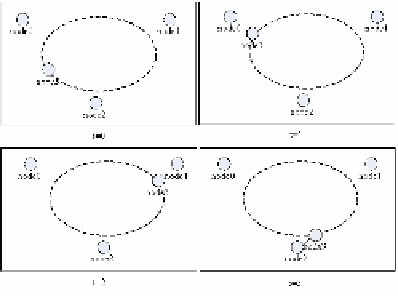Information Technology Reference
In-Depth Information
the “Eventual Transportability” of a communication process in DTNs, we can see from
Fig 1: node0, node1, node2 are fixed nodes, while node3 moves clockwise. Node3
establishes wireless communication links with node 0,1,2 separately during times 1, 2, 3.
Fig. 1.
A typical communication process in DTN
In above communication process, a message “path” is established for any node pair.
Through this path, a message can be successfully transferred between any two nodes
during a given time. This communication process tells us that the traditional “connec-
tivity” concept mainly focuses on the static topological graph, while a static graph is
not enough for describing the whole communication process and the “Eventual
Transportability” of DTNs.
To our knowledge, the store-carry-forward fashion of challenged networks cannot
be well described by known graph theory or other mathematical tools. In this paper, we
bring time dimension into graph theory in order to form a Spatial-Temporal graph.
“Spatial-Temporal Reachability” is proposed to describe the probability of a message
reaching its destination in a given time in DTNs. Spatial-Temporal Reachability is a
key concept of studying a communication system's delivery ratio, robustness and
efficiency.
The rest of this paper is organized as follows: Section 2 gives the related works on
both multi-hop networks and DTNs; Section 3 presents environment and definitions for
the key elements of Spatial-Temporal Reachability; Section 4 gives the Spa-
tial-Temporal Reachability analysis process and results; in Section 5, we compare the
simulation results with the analytical results; some discussions and conclusions are
given in Section 6.
2
Related Works
In this section, recent works on “connectivity” regarding both multi-hop wireless
networks and DTNs are introduced. In the area of traditional multi-hop networks,
Christian Bettstetter[13, 14] et al. have studied a basic concept of Ad Hoc networks: its

